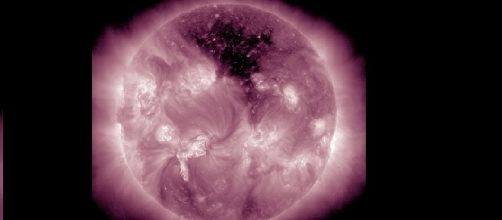Magnetic filed lines not reconnecting back
On an image taken by the Solar Dynamics Observatory (SDO), a huge dark area known as a coronal hole is shown on the Sun. The image, which was taken using the spacecraft ultra-high definition mapping instruments, displays an enormous black region on the upper half of the sun. Coronal holes were discovered for the first time using X-ray telescopes on the Skylab mission back in the 70s.
What is a coronal hole?
Coronal holes are areas of low density plasma in the sun´s corona. They usually appear darker due that the energy in that spot is very low.
They´re formed when magnetic fields arch up and away from the corona, resulting in lower temperature and density in that particular spot of the sun´s surface.
Solar cycle
Coronal holes are formed permanently on the sun; however, they are less notorious during a solar maximum, which is when the magnetic field reverses in the sun. During a solar minimum, coronal holes get formed principally on the sun´s up and bottom extreme regions. Coronal holes are thought to form due that magnetic field lines are unable to reconnect during intense solar activity.
Through these holes on the sun is where rapid solar wind usually escapes to space. Solar wind is known to follow the path of the open filed lines created when coronal holes form; as the region of these holes is very thin, many particles find it easy to break through from within the chromosphere at twice the normal speed of the solar wind.
SDO spacecraft
To study the sun, SDO is equipped with imaging instruments, including an Helioseismic and magnetic Imager (HMI) for studying the magnetic field at varied wavelengths; an Atmospheric Imaging Assembly (AIA) that will study the corona at temperatures ranging from 20 thousand to 20 million degrees and an Extreme Ultraviolet Variability Experiment (EVE) to measure the spectrum in the extreme ultraviolet wavelength.
Coronal holes are particles that are sent into space whenever field lines are unable to reconnect, thus permitting the fast solar wind to escape from the sun. Their formation is important at comprehending better the effects that the solar wind has on the spacecraft and astronauts sent to space.
The largest coronal hole was seen on the sun´s corona on 18 June, 2013. It encompassed almost half of the sun´s diameter.

